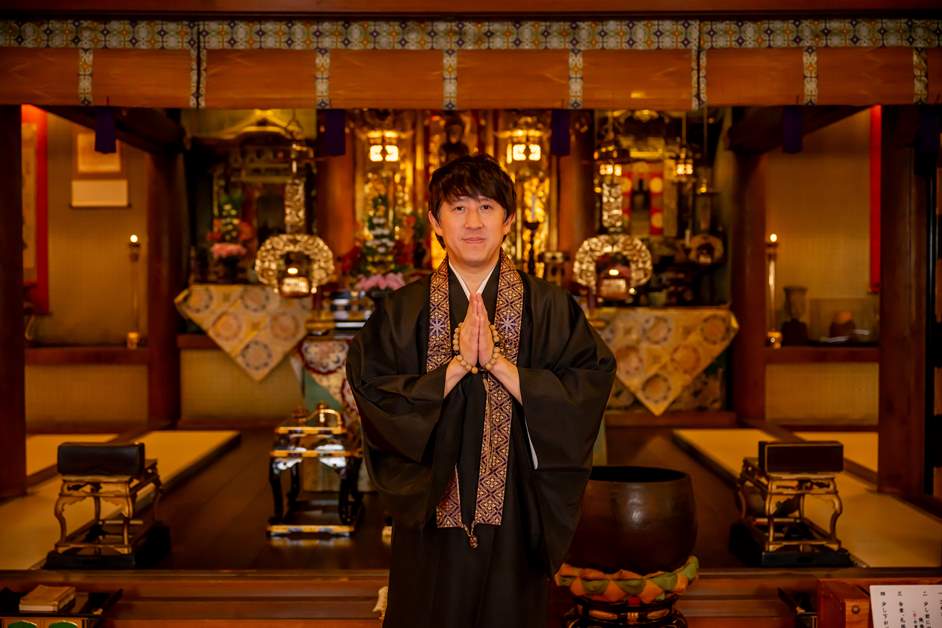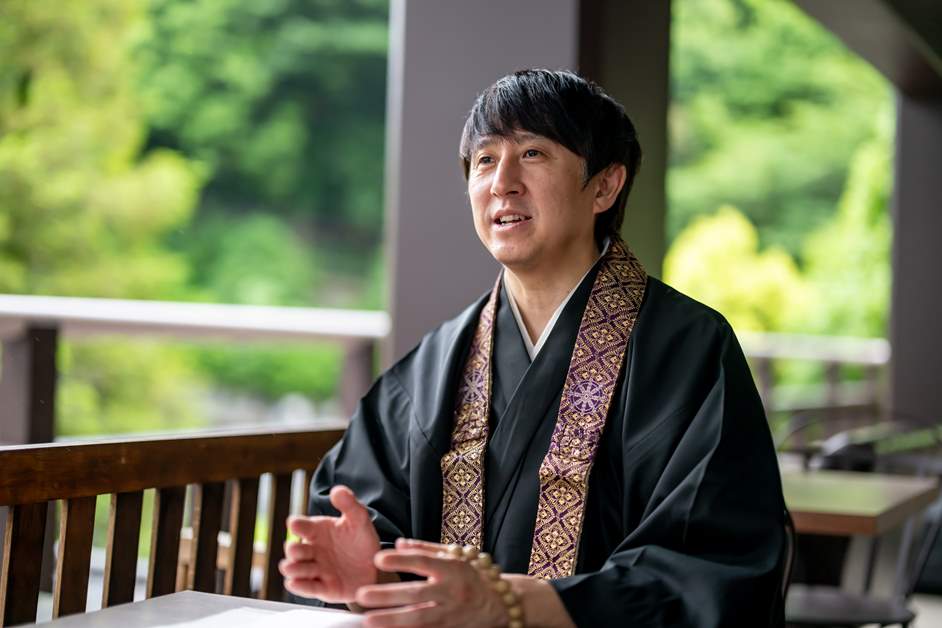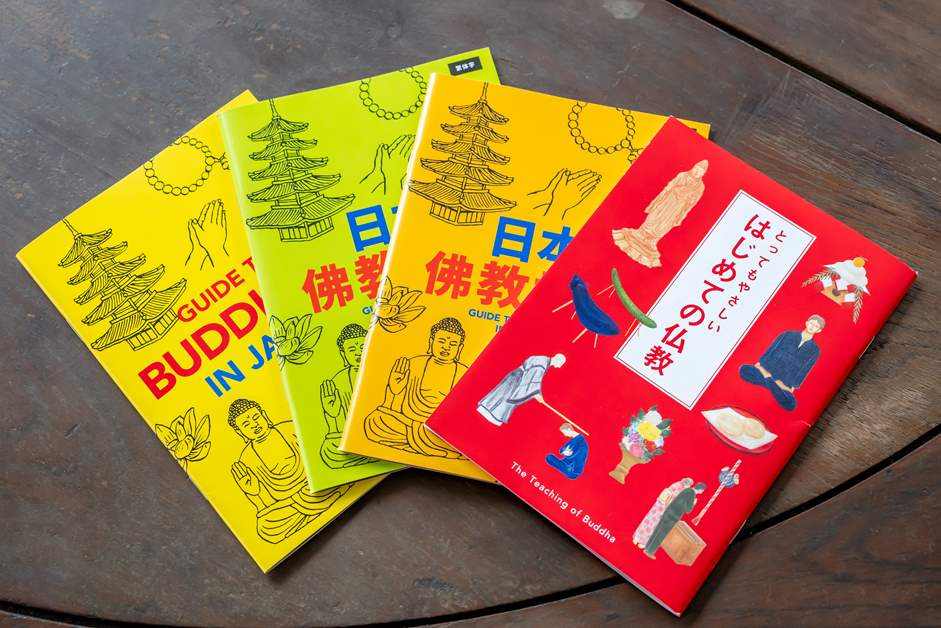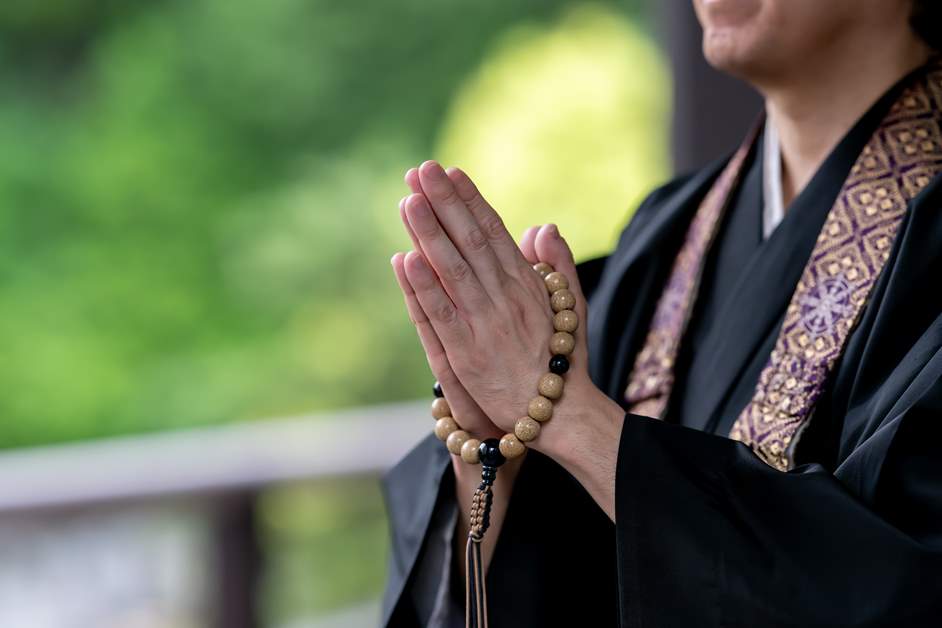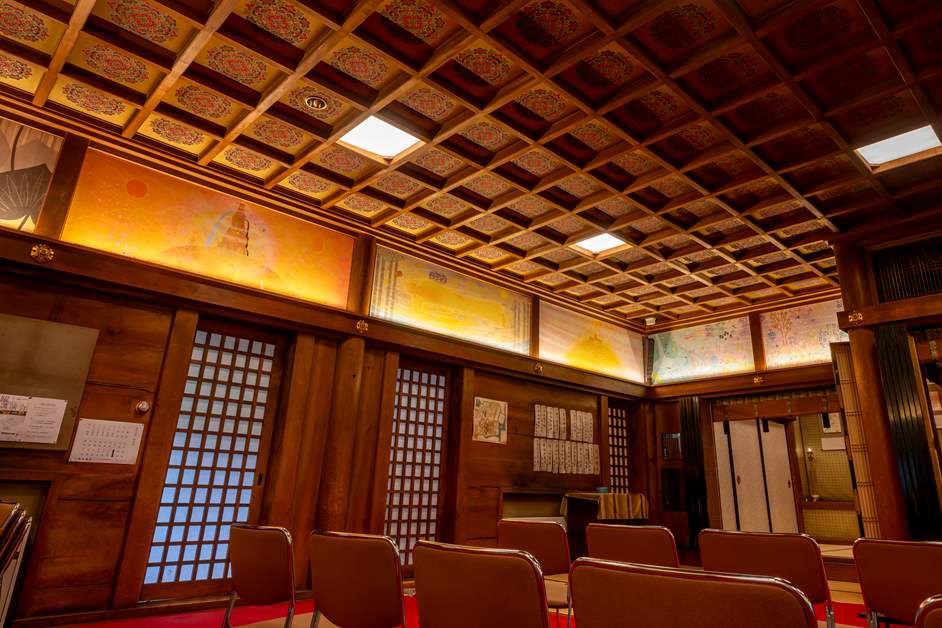Learn Proper Temple Etiquette with Detailed Explanations from a Buddhist Monk!
Minato-ku is home to a variety of temples, including Zojoji Temple, known as the family temple of Tokugawa Ieyasu. There are approximately 280 temples in the area. Recently, due to the influence of inbound tourism, many people from both inside and outside Japan have been visiting these temples. Therefore, it is important for visitors to be aware of the proper etiquette for temple visits. In this article, we spoke with Tomoaki Eda, an active monk and staff member of the Society for the Promotion of Buddhism, which has spreads the teachings of Buddhism. He shared insights on the correct manners for temple visits and provided information about temples in Minato-ku.
Buddhism Teaches the Spirit of Gratitude and Appreciation
—Buddhism is very familiar to Japanese people, but there may be few who truly understand its spirit and culture. Could you start by explaining the basics of Buddhist teachings?
When we talk about Buddhism, it encompasses a vast array of teachings, but one particularly important concept is 'Engi'. We often hear phrases like 'good fortune' or 'bad fortune,' but the Buddhist concept of 'Engi' is somewhat different. In Buddhism, 'Engi' means that 'all things exist in connection with one another.' In other words, humans, animals, and plants are all interconnected, and our current existence is supported by these connections. Therefore, Buddhism can be described as a teaching that upholds the spirit of gratitude and appreciation for all things.
When we talk about Buddhism, it encompasses a vast array of teachings, but one particularly important concept is 'Engi'. We often hear phrases like 'good fortune' or 'bad fortune,' but the Buddhist concept of 'Engi' is somewhat different. In Buddhism, 'Engi' means that 'all things exist in connection with one another.' In other words, humans, animals, and plants are all interconnected, and our current existence is supported by these connections. Therefore, Buddhism can be described as a teaching that upholds the spirit of gratitude and appreciation for all things.
—Gratitude and appreciation are indeed important values for Japanese people.
It is said that the teachings of Buddhism were introduced to Japan around the 6th century. Since then, many temples have been established throughout the country, spreading Buddhist teachings. As a result, Buddhism has permeated every aspect of Japanese thought, customs, and culture. For example, the influence of Buddhist spirit can be seen prominently in the practices of tea ceremony, flower arrangement, Japanese gardens, and shojin-ryori vegetarian cuisine.
It is said that the teachings of Buddhism were introduced to Japan around the 6th century. Since then, many temples have been established throughout the country, spreading Buddhist teachings. As a result, Buddhism has permeated every aspect of Japanese thought, customs, and culture. For example, the influence of Buddhist spirit can be seen prominently in the practices of tea ceremony, flower arrangement, Japanese gardens, and shojin-ryori vegetarian cuisine.
—What activities does the Society for the Promotion of Buddhism undertake to spread such Buddhist teachings?
The Society for the Promotion of Buddhism, which I belong to, is a public interest incorporated foundation recognized by the Cabinet Office. Buddhism encompasses various sects, but our society has been working to spread Buddhist teachings without adhering to any specific sect since 1965, based in Minato-ku for over 50 years. Our activities are diverse. We invite monks and Buddhist scholars from various sects to give lectures and hold events, and we also provide scholarships to those studying Buddhism. Additionally, we hold the 'Cultural Award for the Promotion of Buddhism' annually to honor individuals who have contributed to the promotion and development of Buddhist spirit and culture. Past recipients include photographer Ken Domon and writer Hiroyuki Itsuki, and more recently, Jun Miura, who has driven the recent Buddha statue boom. Furthermore, we donate a book titled 'The Teachings of Buddha' to hotels worldwide, and currently, we publish a booklet called 'Guide to Buddhism' for inbound tourists, which explains how to properly visit temples.
The Society for the Promotion of Buddhism, which I belong to, is a public interest incorporated foundation recognized by the Cabinet Office. Buddhism encompasses various sects, but our society has been working to spread Buddhist teachings without adhering to any specific sect since 1965, based in Minato-ku for over 50 years. Our activities are diverse. We invite monks and Buddhist scholars from various sects to give lectures and hold events, and we also provide scholarships to those studying Buddhism. Additionally, we hold the 'Cultural Award for the Promotion of Buddhism' annually to honor individuals who have contributed to the promotion and development of Buddhist spirit and culture. Past recipients include photographer Ken Domon and writer Hiroyuki Itsuki, and more recently, Jun Miura, who has driven the recent Buddha statue boom. Furthermore, we donate a book titled 'The Teachings of Buddha' to hotels worldwide, and currently, we publish a booklet called 'Guide to Buddhism' for inbound tourists, which explains how to properly visit temples.
—The booklet is available in English, Simplified Chinese, Traditional Chinese, and Japanese, correct?
Yes. We distribute it at temples nationwide, and give it to visitors who request it. It has been very well received, and many people have taken a copy. Additionally, the Society for the Promotion of Buddhism sponsors various activities to spread Buddhist teachings, such as the radio program 'Waraimeshi Tetsuo's Saturday Night Buddhism' broadcasted on FM Osaka. For more details, please visit our society's website.
Yes. We distribute it at temples nationwide, and give it to visitors who request it. It has been very well received, and many people have taken a copy. Additionally, the Society for the Promotion of Buddhism sponsors various activities to spread Buddhist teachings, such as the radio program 'Waraimeshi Tetsuo's Saturday Night Buddhism' broadcasted on FM Osaka. For more details, please visit our society's website.
How to Visit a Temple: Starting with a Bow and Gassho
—Could you please explain the proper etiquette for visiting a temple?
First, when you enter through the temple gate, called the sanmon, make a bow or perform a gassho (palms pressed together) as a greeting to the Buddha. Next, upon entering the temple grounds, you may find a chozuya (a purification fountain). At the chozuya, hold the ladle with your right hand to cleanse your left hand, then switch hands to cleanse your right hand. Finally, pour some water into your palm, rinse your mouth lightly, cover your mouth with your left hand, and spit the water out discreetly. When entering the main hall, bow or perform a gassho again. When praying to the Buddha, it's ideal to use prayer beads draped over both hands while performing a gassho. Unlike at a Shinto shrine, do not clap your hands; simply press them together quietly. When you leave the main hall and when exiting the sanmon, bow or perform a gassho once more as a sign of respect to the Buddha.
First, when you enter through the temple gate, called the sanmon, make a bow or perform a gassho (palms pressed together) as a greeting to the Buddha. Next, upon entering the temple grounds, you may find a chozuya (a purification fountain). At the chozuya, hold the ladle with your right hand to cleanse your left hand, then switch hands to cleanse your right hand. Finally, pour some water into your palm, rinse your mouth lightly, cover your mouth with your left hand, and spit the water out discreetly. When entering the main hall, bow or perform a gassho again. When praying to the Buddha, it's ideal to use prayer beads draped over both hands while performing a gassho. Unlike at a Shinto shrine, do not clap your hands; simply press them together quietly. When you leave the main hall and when exiting the sanmon, bow or perform a gassho once more as a sign of respect to the Buddha.
—So, it's best to bring prayer beads with you?
Yes. Prayer beads are a ritual tool used during worship. The basic type has 108 beads, representing the 108 earthly desires of man, but the type and way they are used can vary by sect. When praying to the Buddha, it's ideal to perform a gassho with the prayer beads. Just as people bring a stamp book to collect temple stamps, you might think of bringing prayer beads as part of the set you bring to a temple visit.
Yes. Prayer beads are a ritual tool used during worship. The basic type has 108 beads, representing the 108 earthly desires of man, but the type and way they are used can vary by sect. When praying to the Buddha, it's ideal to perform a gassho with the prayer beads. Just as people bring a stamp book to collect temple stamps, you might think of bringing prayer beads as part of the set you bring to a temple visit.
—Some temples don't have a chozuya, right?
The practices can differ by Buddhist sect, so some temples may not have a chozuya (purification fountain). Additionally, the rules for goshuin (temple stamps), omikuji (fortunes), and omamori (charms) can vary. Each temple has its own traditions, so there is no single correct way to do things. For example, I am a monk of the Jodo Shinshu sect, and typically, Jodo Shinshu temples do not have omikuji, omamori, or goshuin. Some temples list their rules on their websites, so it’s a good idea to check online beforehand or ask temple staff if you have any questions.
The practices can differ by Buddhist sect, so some temples may not have a chozuya (purification fountain). Additionally, the rules for goshuin (temple stamps), omikuji (fortunes), and omamori (charms) can vary. Each temple has its own traditions, so there is no single correct way to do things. For example, I am a monk of the Jodo Shinshu sect, and typically, Jodo Shinshu temples do not have omikuji, omamori, or goshuin. Some temples list their rules on their websites, so it’s a good idea to check online beforehand or ask temple staff if you have any questions.
—I hear that there has been an increase in visitors from overseas recently. Is there anything you would like to convey to them?
I would like overseas visitors to put their hands together in prayer to Buddha when they visit temples, but it is also important for them to observe basic etiquette. For example, some temples require you to remove your shoes before entering the main hall. While it may not be customary in many countries to remove shoes before entering a building, please be sure to follow this rule in temples that require it. Also, always check to see if photography is allowed. Once inside the temple, please observe etiquette by removing your hat, taking off your sunglasses, and refraining from eating or drinking.
I would like overseas visitors to put their hands together in prayer to Buddha when they visit temples, but it is also important for them to observe basic etiquette. For example, some temples require you to remove your shoes before entering the main hall. While it may not be customary in many countries to remove shoes before entering a building, please be sure to follow this rule in temples that require it. Also, always check to see if photography is allowed. Once inside the temple, please observe etiquette by removing your hat, taking off your sunglasses, and refraining from eating or drinking.
—Is it acceptable to visit temples for sightseeing purposes?
It is fine to enter a temple for sightseeing, but remember that temples are also places of worship. Many people treasure these places, so it's important to be considerate and respectful. I think it's important to maintain the sacred atmosphere and show reverence for the religious significance of the place.
It is fine to enter a temple for sightseeing, but remember that temples are also places of worship. Many people treasure these places, so it's important to be considerate and respectful. I think it's important to maintain the sacred atmosphere and show reverence for the religious significance of the place.
Temples to Visit in Minato-ku and a Temple in Germany
—Minato-ku seems to have a particularly large number of temples. Zojoji Temple is very famous, but could you recommend a few other notable temples that you want others to know about?
In addition to Zojoji Temple (Jodo sect), Minato-ku has many other historically significant and impressive temples. Zenpukuji (Jodo Shinshu Hongwanji sect) is the oldest temple in Minato-ku, and its 'mountain name', Azabusan, is the origin of the name of the Azabu area. Zuishoji Temple (Obaku sect) has several structures, such as the daiyuhoden principal hall, that have been designated as important cultural properties by the national government. In addition, the adjacent priests' quarters were designed by the famous architect Kengo Kuma. Kakurinji Temple (Nichiren sect) is also known as Seishoko, was named after the enshrined spirit tablet and statue of the Sengoku period warlord Kato Kiyomasa.
In addition to Zojoji Temple (Jodo sect), Minato-ku has many other historically significant and impressive temples. Zenpukuji (Jodo Shinshu Hongwanji sect) is the oldest temple in Minato-ku, and its 'mountain name', Azabusan, is the origin of the name of the Azabu area. Zuishoji Temple (Obaku sect) has several structures, such as the daiyuhoden principal hall, that have been designated as important cultural properties by the national government. In addition, the adjacent priests' quarters were designed by the famous architect Kengo Kuma. Kakurinji Temple (Nichiren sect) is also known as Seishoko, was named after the enshrined spirit tablet and statue of the Sengoku period warlord Kato Kiyomasa.
—So Zenpukuji is in Motoazabu, while Zuisouji and Kakurinji are in Shirokanedai, correct?
Yes, that's right. In addition, Sengakuji Temple (Soto sect) is known for the graves of the forty-seven ronin, and many people still visit on December 14, the anniversary of their attack. Koyasan Tokyo Betsuin (Koyasan Shingon sect) is a branch of Kongobuji Temple, the main temple of Koyasan Shingon Buddhism, and offers experiences such as sutra copying and Ajikan meditation. There are also many other fascinating temples in Minato-ku. I hope everyone will consider visiting and paying their respects.
Yes, that's right. In addition, Sengakuji Temple (Soto sect) is known for the graves of the forty-seven ronin, and many people still visit on December 14, the anniversary of their attack. Koyasan Tokyo Betsuin (Koyasan Shingon sect) is a branch of Kongobuji Temple, the main temple of Koyasan Shingon Buddhism, and offers experiences such as sutra copying and Ajikan meditation. There are also many other fascinating temples in Minato-ku. I hope everyone will consider visiting and paying their respects.
—Sengakuji and the Koyasan Tokyo Betsuin are in Takanawa. Today, we're speaking with you at Komyoji Temple in Toranomon. What are some of the features of Komyoji Temple?
Komyoji Temple (Jodo Shinshu Hongwanji sect) has an open terrace where you can relax while enjoying a view of Tokyo Tower. This temple is actually run by my relatives, and I sometimes help out here as well.
Komyoji Temple (Jodo Shinshu Hongwanji sect) has an open terrace where you can relax while enjoying a view of Tokyo Tower. This temple is actually run by my relatives, and I sometimes help out here as well.
—I heard that you have also spent time at a temple in Germany.
I am the second son of a temple in Kitakyushu and a monk of the Jodo Shinshu Hongwanji sect. I served at Tsukiji Hongwanji Temple until 2011, and then at Ekoji Temple in Düsseldorf, Germany, from 2011 to 2017.
I am the second son of a temple in Kitakyushu and a monk of the Jodo Shinshu Hongwanji sect. I served at Tsukiji Hongwanji Temple until 2011, and then at Ekoji Temple in Düsseldorf, Germany, from 2011 to 2017.
—I didn't know there was a Buddist temple in Düsseldorf. How do people in Europe perceive Buddhism?
Düsseldorf has a Japanese district, so there are a relatively large number of Japanese people there. Ekoji Temple is also located in this area and is considered the largest Japanese Buddhist temple in Europe, so it attracts many tourists from all over the continent. It was striking to see that many people associate Buddhism more with practices such as Zen meditation and general meditation, rather than as a religion. In addition, many people see Buddhism as a practical philosophy for living a happy life, and most have a positive perception of it. In fact, many visitors to Ekoji Temple seemed to have a deep sense of respect and awe for Buddhism.
Düsseldorf has a Japanese district, so there are a relatively large number of Japanese people there. Ekoji Temple is also located in this area and is considered the largest Japanese Buddhist temple in Europe, so it attracts many tourists from all over the continent. It was striking to see that many people associate Buddhism more with practices such as Zen meditation and general meditation, rather than as a religion. In addition, many people see Buddhism as a practical philosophy for living a happy life, and most have a positive perception of it. In fact, many visitors to Ekoji Temple seemed to have a deep sense of respect and awe for Buddhism.
—So once again, it's important to have those feelings when visiting temples in Japan as well, correct?
You should show respect not only to the temple staff, but also to the people who visit the temple every day. Always approach your visit with a sense of reverence for the Buddha. If you are unsure of the proper etiquette, don't hesitate to ask the temple staff to avoid any disrespect. I hope that by visiting temples, more people will have the opportunity to connect with Buddhism.
You should show respect not only to the temple staff, but also to the people who visit the temple every day. Always approach your visit with a sense of reverence for the Buddha. If you are unsure of the proper etiquette, don't hesitate to ask the temple staff to avoid any disrespect. I hope that by visiting temples, more people will have the opportunity to connect with Buddhism.
<Interview Cooperation: Komyoji Temple (Jodo Shinshu Hongwanji sect)>
Address: 3-25-1 Toranomon, Minato-ku, Tokyo
https://www.komyo.net/
<Interview Cooperation: The Society for the Promotion of Buddhism>
https://www.bdk.or.jp/
Address: 3-25-1 Toranomon, Minato-ku, Tokyo
https://www.komyo.net/
<Interview Cooperation: The Society for the Promotion of Buddhism>
https://www.bdk.or.jp/




